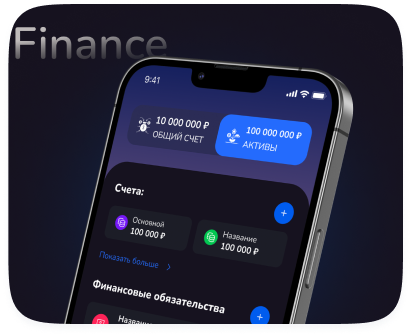
We build mobile apps





We work directly with every client
We deliver solutions with guaranteed results.

We build mobile apps






















It’s similar to buying a car at a dealership: you can go with the basic model, or choose a fully loaded version — it all depends on your needs and goals.

How to create YOUR OWN ChatGPT?

How to PROPERLY create a mobile app in 2024 | Step by step

You pay > We work > You receive the results. If you’re satisfied, you pay the next installment.
We need to have a call and discuss your specific requirements.
One thing we can say for sure: projects under 500,000 rubles are not feasible — we can’t deliver the required quality for less.
We launch, gather user feedback, and add new features that help you earn more from the app.
During development, I always design the architecture to make future updates and improvements easy and convenient.
Some apps perform better with influencer marketing, others through ad networks, and sometimes it’s even effective to buy a contact list and set up retargeting 😊
It all depends on your project’s specifics and is discussed personally.
How we can help:
- Set up ASO (App Store Optimization) and create an attractive app store page to drive free, organic installs.
- Help you develop the right promotion strategy tailored to your app.
- Share contacts of advertising experts I personally work with.
Спросить ChatGPT
The only ongoing cost is paying for the server (hosting).
You pay a subscription fee for the server. The more users your app has, the more server resources it consumes, and the higher the hosting costs.
At the early stages, when you have few users, the server will be FREE.
After that, the cost will gradually increase, but it remains affordable.
For example, an app with 100,000 users spent about $150 per month on hosting.
Mobile App Development Cost: Free Quote & Consultation
Mobile app development is a crucial aspect of modern business strategy. Whether you're a startup or an established enterprise, a well-designed and functional mobile app can significantly enhance your brand's reach, improve customer engagement, and drive revenue. However, before embarking on this journey, it's essential to understand the various factors that influence the mobile app development cost. This article provides a comprehensive overview of the key elements that contribute to the overall expense and offers insights into how to optimize your budget effectively. We also offer a free quote and consultation to help you get started on your app development project.
Introduction: Why Understanding Mobile App Development Cost is Crucial
The mobile app market is booming, and businesses are increasingly recognizing the importance of having a strong mobile presence. Developing a successful app, however, requires careful planning and a thorough understanding of the associated costs. The price of developing a mobile app can vary widely, depending on factors such as the complexity of the app, the platform it will be developed for, and the location of the development team. Knowing these factors upfront allows you to create a realistic budget and avoid unexpected expenses down the line. Failing to understand the cost implications can lead to project delays, budget overruns, and ultimately, a less-than-satisfactory product. Therefore, understanding the elements impacting mobile app development cost is paramount for success.
Factors Influencing Mobile App Development Cost
Several factors contribute to the overall cost of mobile app development. These factors can be broadly categorized into the following areas:
1. App Complexity and Features
The complexity of the app and the number of features it includes are perhaps the most significant determinants of cost. A simple app with basic functionality will naturally be less expensive to develop than a complex app with advanced features. Consider these aspects:
- Basic Features: These include things like user registration, login, profile management, basic data input and display, and simple search functionality. Apps with only these features will be on the lower end of the cost spectrum.
- Intermediate Features: These features involve more complex data handling, integration with external services, custom UI/UX designs, e-commerce functionality (shopping carts, payment gateways), and push notifications.
- Advanced Features: These are the most expensive to implement and include features such as real-time data synchronization, video streaming, advanced analytics, artificial intelligence (AI) integration, augmented reality (AR), virtual reality (VR), and complex database management.
The more complex the features, the more time and expertise are required from the development team, which directly translates to a higher cost. Careful consideration of which features are *essential* versus *nice-to-have* is crucial during the planning phase.
2. Platform (iOS, Android, or Cross-Platform)
The platform(s) you choose to develop your app for will also affect the cost. Developing for both iOS (Apple) and Android requires separate development efforts, as each platform uses different programming languages and development tools. Consider these platform options:
- iOS Development: iOS apps are developed using Swift or Objective-C. The iOS ecosystem is known for its consistent user experience and stricter app store guidelines.
- Android Development: Android apps are developed using Java or Kotlin. Android has a larger market share globally but also presents fragmentation challenges due to the variety of devices and operating system versions.
- Cross-Platform Development: Cross-platform development allows you to build an app that can run on both iOS and Android using a single codebase. Frameworks like React Native, Flutter, and Xamarin are popular choices for cross-platform development. While this can potentially save time and money, it may also come with limitations in terms of performance or access to native device features.
Choosing to develop natively for both iOS and Android will generally be more expensive than developing for a single platform or using a cross-platform approach. However, native apps typically offer better performance and a more seamless user experience.
3. UI/UX Design
The user interface (UI) and user experience (UX) design are critical for the success of any mobile app. A well-designed app should be visually appealing, intuitive to use, and provide a seamless experience for users. The complexity of the UI/UX design will significantly impact the cost.
- Basic UI/UX: This involves using standard UI components and a simple design.
- Custom UI/UX: This involves creating unique UI elements, animations, and interactions that are tailored to your brand and target audience. Custom designs require more time and expertise from the design team.
- Advanced UI/UX: This includes incorporating complex animations, interactive elements, and personalized user experiences based on user behavior and preferences.
Investing in a high-quality UI/UX design can significantly improve user engagement and retention, making it a worthwhile investment, even if it increases the initial mobile app development cost.
4. Development Team Location and Expertise
The location and expertise of the development team play a significant role in determining the cost. Development rates vary considerably across different regions. For example, development rates in North America and Western Europe are typically higher than in Eastern Europe or Asia. Also, consider the experience level of the team:
- Freelancers: Hiring freelancers can be a cost-effective option, but it requires careful vetting to ensure they have the necessary skills and experience.
- In-House Team: Building an in-house development team provides more control over the development process but can be expensive in terms of salaries, benefits, and overhead.
- Outsourcing to an Agency: Outsourcing to a reputable app development agency provides access to a team of experienced professionals with expertise in various areas of mobile app development. This option often strikes a good balance between cost and quality.
While lower development rates may seem attractive, it's important to consider the quality of work and communication skills of the development team. A cheaper team that delivers a subpar product can end up costing more in the long run due to rework and maintenance.
5. Backend Infrastructure and APIs
Many mobile apps require a backend infrastructure to store and manage data, handle user authentication, and provide other essential services. The cost of the backend infrastructure depends on the complexity of the app and the amount of data it needs to handle. Additionally, the integration with Application Programming Interfaces (APIs) also adds to the cost.
- Server Infrastructure: This includes the cost of servers, databases, and other infrastructure components. Cloud-based solutions like AWS, Azure, and Google Cloud are popular choices for backend infrastructure.
- APIs: APIs are used to integrate the app with external services, such as social media platforms, payment gateways, and mapping services. Integrating with multiple APIs can increase the development cost.
- Data Storage: The amount of data the app needs to store will affect the cost of the backend infrastructure. Apps that handle large amounts of data will require more storage space and processing power.
The cost of the backend infrastructure can be significant, especially for complex apps with large data requirements. Careful planning and optimization of the backend architecture are essential for minimizing costs.
6. Testing and Quality Assurance
Thorough testing and quality assurance are crucial for ensuring the app is bug-free, performs well, and provides a positive user experience. The cost of testing depends on the complexity of the app and the number of platforms and devices it needs to be tested on.
- Unit Testing: Testing individual components of the app to ensure they function correctly.
- Integration Testing: Testing the interaction between different components of the app.
- System Testing: Testing the entire app as a whole.
- User Acceptance Testing (UAT): Testing the app with real users to gather feedback and identify any usability issues.
- Performance Testing: Evaluating the app's performance under different load conditions.
- Security Testing: Identifying and addressing potential security vulnerabilities.
Adequate testing is essential for delivering a high-quality app and avoiding negative reviews and user dissatisfaction. Skipping or underfunding testing can lead to costly problems down the road. This is a critical aspect of managing the mobile app development cost effectively.
7. App Store Submission and Maintenance
Submitting your app to the Apple App Store or Google Play Store involves a one-time fee and requires adherence to their respective guidelines. Furthermore, ongoing maintenance and updates are necessary to keep the app running smoothly and address any bugs or security vulnerabilities.
- App Store Fees: Apple charges an annual developer fee, while Google charges a one-time registration fee.
- Maintenance: This includes fixing bugs, updating the app to support new operating system versions, and adding new features.
- Marketing and Promotion: Promoting your app to attract users can be a significant ongoing expense.
Budgeting for app store submission, maintenance, and marketing is essential for the long-term success of your mobile app. Consider these as ongoing expenses and not just one-time costs.
Estimated Cost Ranges for Mobile App Development
Based on the factors discussed above, the cost of developing a mobile app can range from a few thousand dollars to hundreds of thousands of dollars. Here's a general overview of the estimated cost ranges:
- Simple App: $5,000 - $20,000 (e.g., a basic task management app or a simple utility app).
- Medium Complexity App: $20,000 - $80,000 (e.g., an e-commerce app with basic features or a social networking app).
- Complex App: $80,000+ (e.g., a complex gaming app, a healthcare app with advanced features, or an enterprise-level app).
These are just estimates, and the actual cost can vary depending on the specific requirements of your project. The best way to get an accurate estimate is to request a free quote from a reputable app development company.
Strategies to Reduce Mobile App Development Cost
While the cost of mobile app development can be significant, there are several strategies you can use to reduce expenses without compromising quality:
- Define Your Requirements Clearly: A well-defined scope of work will help avoid scope creep and unnecessary features.
- Prioritize Features: Focus on developing the essential features first and add additional features later if budget allows.
- Choose the Right Platform: Consider developing for a single platform initially and expanding to other platforms later.
- Use Cross-Platform Development: Cross-platform development can be a cost-effective option if it meets your performance and functionality requirements.
- Leverage Open-Source Libraries and Frameworks: Using open-source libraries and frameworks can save time and effort on development.
- Optimize UI/UX Design: Focus on creating a user-friendly and intuitive design that is not overly complex.
- Thoroughly Test the App: Investing in thorough testing upfront can prevent costly bug fixes and rework later.
- Consider Outsourcing: Outsourcing to a reputable development team in a region with lower development rates can save money.
Table: Key Factors Affecting Mobile App Development Cost
| Factor | Description | Impact on Cost |
|---|---|---|
| App Complexity | Number and complexity of features. | High: More features = higher cost. |
| Platform (iOS, Android) | The platform(s) the app will be developed for. | Medium: Developing for multiple platforms increases cost. |
| UI/UX Design | Complexity and customization of the user interface and experience. | Medium: Custom designs are more expensive. |
| Development Team Location | Geographic location of the development team. | High: Rates vary significantly by region. |
| Backend Infrastructure | Complexity of the server-side infrastructure and APIs. | Medium: Complex backend = higher cost. |
| Testing and QA | Thoroughness of testing and quality assurance processes. | Medium: Comprehensive testing is essential. |
| Maintenance and Support | Ongoing maintenance, updates, and bug fixes. | Low (Ongoing): Recurring cost. |
The Importance of a Free Quote and Consultation
Obtaining a free quote and consultation from a reputable mobile app development company is a crucial step in the planning process. A consultation allows you to discuss your project requirements in detail and receive a personalized estimate of the mobile app development cost. It also provides an opportunity to assess the company's expertise, communication skills, and development process. During the consultation, be prepared to provide as much information as possible about your app's features, target audience, and desired platform(s). The more information you provide, the more accurate the estimate will be.
Conclusion: Planning for Success
Understanding the factors that influence mobile app development cost is essential for creating a realistic budget and planning for success. By carefully considering the complexity of your app, the platform you choose, the UI/UX design, the development team's location, and the backend infrastructure, you can make informed decisions that will help you optimize your budget and deliver a high-quality app. Don't hesitate to seek a free quote and consultation from experienced app development professionals to get a clear understanding of the potential costs involved and ensure a successful outcome for your project. Remember that investing in quality and careful planning upfront can save you time and money in the long run. Good luck with your mobile app development journey!






